Last Updated on February 18, 2025 by Kittredge Cherry
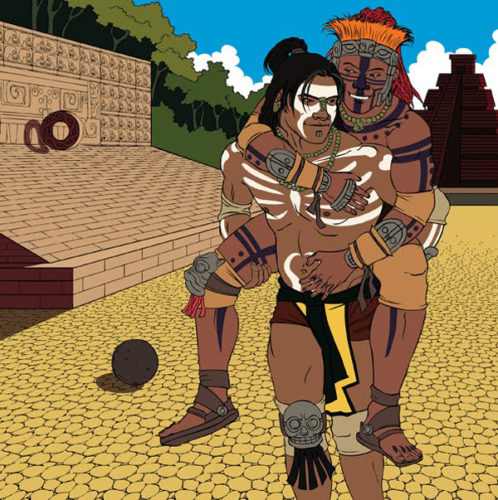
Two-spirit Native Americans are honored at Q Spirit for Indigenous Peoples’ Day (Oct 14, 2024). It is an alternative to the U.S. national holiday Columbus Day, which commemorates the arrival of European explorer Christopher Columbus in the Americas on Oct. 12, 1492.
Almost all Native American tribes traditionally recognized “two-spirit” people of non-binary or mixed gender. Sometimes they played a spiritual role. They appear as sacred figures in Native American rituals and myths. Indigenous Peoples’ Day is a suitable time to remember the two-spirit who were killed when Europeans brought violence against queer people to America. They include Tibira do Maranhão, who is considered a saint by the LGBTQ community because he was the first indigenous person executed for “sodomy” by Europeans in Brazil in 1614.
In 2021 Joe Biden became the first U.S. president to issue a proclamation for Indigenous Peoples Day. Many states and at least 130 U.S. cities celebrate Indigenous Peoples Day instead of or in addition to Columbus Day.
Before Columbus arrived, most Native American societies valued people who blended male and female roles or characteristics. Their languages had words for third and sometimes even fourth genders. “Two spirit” is one of the many and varied Native American terms for alternative genders because one body housed both feminine and masculine spirits. Sometimes they served as spiritual guides who mediated between the realms of body and spirit, male and female. From a Western cultural viewpoint, the two-spirited people have been seen as lesbian, gay, bisexual, transgender (LGBT) or queer.
[New in 2024: Kateri Tekakwitha (1656-1680), the first Native American to be canonized as a Roman Catholic saint, had a close female friend and companion: Marie-Thérèse Tegaiaguenta. They dreamed of founding a religious order for Native women together, but Jesuit priests rejected the idea. Their relationship is downplayed in most hagiographies, but it can be an inspiration to LGBTQ people. A few have even speculated that they were a lesbian couple. There is no question that they were soulmates. A full article about them is in the works for posting on Q Spirit in the future.]
Indigenous queer love in contemporary art
Contemporary artists have re-envisioned the freedom of two-spirit people before the Europeans arrived. In the image above, Wisconsin artist Ryan Grant Long includes unknown Mayan athletes enjoying a playful moment together on the ball game field in the pre-Columbian Americas. It comes from his series “Fairy Tales” series on the history of same-sex love around the world. For more info, see my article Artist paints history’s gay couples: Interview with Ryan Grant Long.
Two-spirit love in various indigenous cultures is depicted by Felix d’Eon, a Mexican Latinx painter and activist dedicated to the art of queer love, romance, and sensuality. For example, he paints a Dilbaa, a female-bodied person with a masculine essence in the Navajo (or Diné) system of four genders. The Navajo nation is in the southwestern United States.
In the painting “Los Emberas,” d’Eon shows an embrace between a Were Pa (“false woman” or transwoman) and her male lover in the Emberá tribe from Colombia.
Prints of “Los Emberas” are available at Felix d’Eon’s Etsy shop. (Warning: nudity.) It includes images of queer two-spirit love in different communities in North and Central America, “imagining love and acceptance where too little exists today.”
Muxe is the third gender in the indigenous Zapotec culture of southern Mexico’s Oaxaca region. Muxes are usually people who were assigned male at birth and grew to identify as different genders, but others defy gender completely. D’Eon depicts their non-binary love in “Muxe Ne Nadxii” (My Muxe Forever).
Two-spirit people were not only accepted in many Native American societies, but also appear as sacred figures in Native American rituals and mythology. Xochipilli, the flower prince, is the Aztec god of two-spirit or queer people, as well as art, music, dance, games joy and beauty. Xochipilli is associated with gender-variance and same-sex eroticism while also being a fertility god. The Zuni have a two-spirit god called Ko’lhamana, and Hopi and Acoma-Laguna myths tell about a whole tribe of two-spirit people called the Storoka.
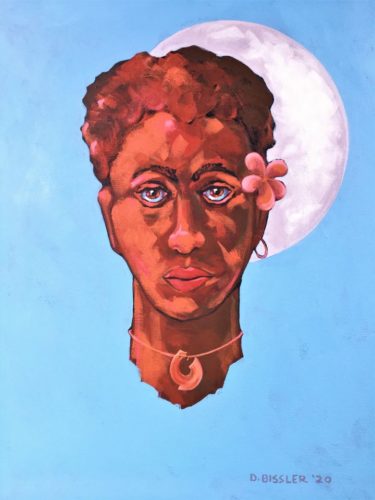
“Mahu” by Daniel Bissler
Artist Daniel Bissler painted “Mahu” as an homage to the third-gender people of Hawaii. Mahu play important spiritual and social roles in traditional Hawaiian culture. Mahu means “in the middle,” and Bissler chose pink, blue and white colors to evoke a gender between male and female. The moon forms a kind of off-center halo behind the head of the mahu.
Artist Brandon Buehring included several two-spirit groupings in his “Legendary Love: A Queer History Project.” In one sketch he portrays Warharmi, a “half-man, half-woman” and twins named Madkwahomai from the creaton myth of the Tipai tribe of the Kumeyaay people in California’s Imperial Valley.
Buehring uses pencil sketches and essays “to remind queer people and our allies of our sacred birthright as healers, educators, truth-tellers, spiritual leaders, warriors and artists.” The project features 20 sketches of queer historical and mythological figures from many cultures around the world. He has a M.Ed. degree in counseling with an LGBT emphasis from North Carolina State University in Raleigh. He works in higher education administration as well as being a freelance illustrator based in Northampton, Massachusetts.
While Europeans were mostly hostile to two-spirit people among the Native Americans whom they converted to Christianity, a contemporary icon offers hope of reconciliation by showing holy same-sex love with both Christian and Native American imagery. John Giuliani’s “Jesus and the Beloved Disciple” shows Jesus and his male beloved in the native dress of the Aymara Indians, descendants of the Incas who still live in the Andean regions of Chile, Peru and Bolivia. Giuliani is an Italian-American artist and Catholic priest who is known for making Christian icons with Native American symbols. He studied icon painting under a master in the Russian Orthodox style, but chose to expand the concept of holiness to include Native Americans, the original inhabitants of the Americas.
An antidote and update to the terrifying historical images is provided by Kent Monkman, a Canadian artist of Cree ancestry whose work has strong queer and gay male imagery dealing with sexuality and Christianity. He decolonizes and reimagines grandiose 19th-century history paintings from a queer indigenous viewpoint. For example, in “A Wedding at Sodom” he shows a priest blessing the same-sex wedding of two men in the midst of a multi-racial brawl and celebration on the frontier of European settlement in the Wild West. It is based on how European trappers and traders gathered with indigenous people every spring in early 19th-century America for a raucous party and trading event called the Rendezvous.
Indigenous people honor queer saints
In an example of reversal and cross-fertilization, indigenous LGBTQ people examine and sometimes celebrate queer Christian saints. Artists have created a variety of LGBTQ visions of the Virgin of Guadalupe, a vision of the Virgin Mary that appeared to indigenous Aztec peasant Juan Diego outside Mexico City in 1531 and spoke to him in the native Nahuatl language. Queer and trans people participate in ritual cross-dressing every Jan. 20 at the Tunantada festival honoring saints Sebastian (sometimes considered the patron saint of gay men) and Fabian in Jauja, Peru. This Andean festival is explored in “Cuir Devotion,” a storytelling ethnography performance in which Enzo Vasquez Toral performs as a fictional Andean-inspired drag queen.
Queer indigenous people in historical art
The earliest known European depictions of Native Americans include two-spirit people. “Employments of the Hermaphrodites” is based on a watercolor made by Jacques Le Moyne de Morgues while exploring Florida in the 1560s. It illustrates his report that two-spirit people’s duties included caring for the sick and carrying the dead on stretchers.
George Catlin, famous artist who specialized in portraits of Native Americans in the Old West, sketched the “Dance to the Berdache” in the 19th century while on the Great Plains with the Sac and Fox Nation. He depicted a ceremonial dance to celebrate the Berdache, a European term for two-spirit people. But Catlin refused to give two-spirit people a place in his paintings of “traditional” Indian life.
Executions for homosexuality were common in Europe for centuries, and Europeans soon imported homophobic violence to the Americas. In perhaps earliest recorded example, the Spanish explorer Vasco Núñez de Balboa found homosexuality among the Native American chiefs in 1594 at Quarqua in Panama. He ordered 40 of these two-spirited people thrown to his war dogs to be torn apart and eaten alive to stop the “stinking abomination.”
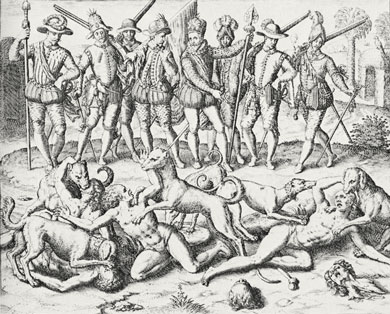
Balboa executing two-spirit Native Americans for homosexuality in 1513 in Panama — engraving by Théodore De Bry, 1594 (Wikimedia Commons).
LGBTQ activists are reclaiming and honoring some the the queer people who were killed by colonists. Tibira do Maranhão, who is known as “the first indigenous gay martyr of Brazil,” was executed for sodomy by French missionaries in 1614.
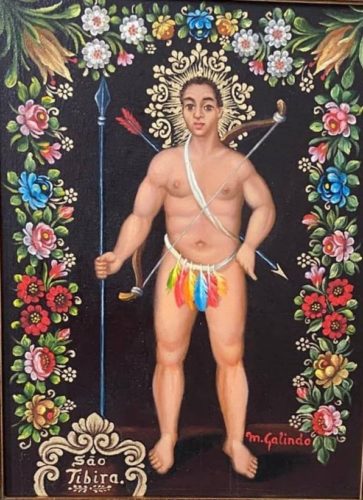
“São Tibira” (Saint Tibira) icon by Miguel Galindo
Contemporary LGBTQ activists are working to get Tibira canonized as a saint.
We’wha of Zuni: Two-spirit ambassador met U.S. president
Despite the violence, some two-spirit individuals are still remembered in history and contemporary art. They include We’wha of Zuni and the Woman Chief known as Pine Leaf.
We’wha was a two-spirit Native American Zuni who served as a cultural ambassador for her people, including a visit with a U.S. president in 1886. We’wha (pronounced WAY-wah) was the most famous “lhamana,” the Zuni term for a male-bodied person who lived in part as a woman. Lhamanas chose to specialize in crafts instead of becoming warriors or hunters.
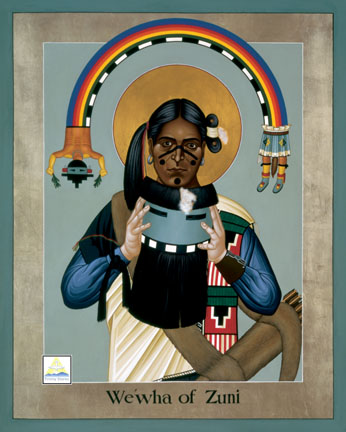
“We’wha of Zuni” by Robert Lentz. Prints of “We’wha of Zuni” are available at TrinityStores.com.
We’wha (1849-1896) was a skilled weaver and potter who helped Anglo-American scholars studying Zuni society. In 1886 We’wha traveled from her home in New Mexico to Washington DC, where she met president Grover Cleveland. She was welcomed as a celebrity during her six months in Washington. Everyone assumed that the 6-foot-tall “Indian princess” was female.
The spiritual side of We’wha is emphasized an icon by Brother Robert Lentz, is a Franciscan friar known for his innovative and LGBT-positive icons. She is dressed for a religious ceremony as she prepares to put on the sacred mask of the man-woman spirit Kolhamana. It is one of 10 Lentz icons that have sparked controversy since in 2005 when conservative Roman Catholic leaders accused Lentz of glorifying sin and creating propaganda for a progressive sociopolitical agenda with these “Images That Challenge.”
Jim Ru painted We’Wha with a dramatic blue background His icon was included in his show “Transcendent Faith: Gay, Lesbian and Transgendered Saints” in Bisbee Arizona in the 1990s.
Ru discusses We’Wha in a video.
We’wha is the subject of the book “The Zuni Man-Woman” by gay anthropologist Will Roscoe. He also wrote “Changing Ones: Third and Fourth Genders in Native North America
” and “Jesus and the Shamanic Tradition of Same-Sex Love
.” Roscoe’s website willsworld.org offers resources in the Native American two-spirit tradition, third genders in the ancient world, and studies in early Christianity.
Pine Leaf rose to become Woman Chief
“Woman Chief” is one of the names for the two-spirit tomboy born around 1800 to the Gros Ventre tribe. She was captured by the Crow nation when she was 10 and was so adept at hunting and warfare that she rose to become their chief.
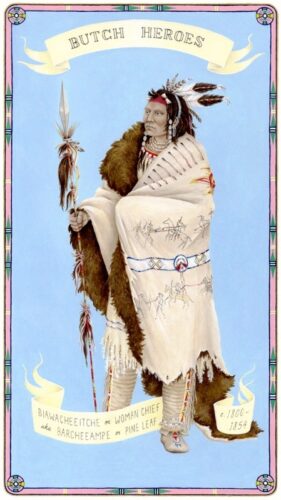
“Biawacheeitche or Woman Chief aka Barcheeampe or Pine Leaf” by Ria Brodell
She is portrayed in the “Butch Heroes” series by nonbinary trans Boston artist Ria Brodell. The book version of “Butch Heroes” is available now. For more on Brodell’s work, see my article “Artist paints history’s butch heroes.”
Historical accounts say that she wore women’s clothes but had “all the style of a man and chief,” with “her guns, bows, lances, war horses, and even two or three young women as wives.”
She was killed in 1854 by the Gros Ventre tribe, but her story lived on in the popular memoirs of a freed slave and fur trader named James Beckwourth. He called her Pine Leaf because he refused his multiple marriage proposals by saying she would wed him “when the pine leaves turn yellow.” Later he figured out that pine leaves never turn yellow.
Prayers
Q Spirit’s Litany of Queer Saints includes this line:
“Two-Spirit people, whose indigenous cultures recognized alternative genders and whose tribal nations continue today despite colonization, inspire us to reclaim gender diversity.”
LGBTQ links related to Indigenous Peoples’ Day
Queer/trans/intersex indigenous history by Maya Gonzalez
Lakota Rainbow Christ Prayer highlights Native American cultures: Wígmuŋke-Waníkiya Wočhékiye
___
Related book:
“Changing Ones: Third and Fourth Genders in Native North America” by Will Roscoe
Land acknowledgement
Q Spirit is based in Los Angeles, California, the ancestral homeland and unceded territory of the Tongva / Kizh / Gabrielino peoples. Q Spirit honors their elders and descendants — past, present, and emerging — as they continue to inhabit and care for these lands and waters. For the Los Angeles County land acknowledgement, developed in collaboration with leaders from local tribes, click here:
https://lacounty.gov/government/about-la-county/land-acknowledgment/
___
Top image credit:
“Unknown Mayan Couple” by Ryan Grant Long
___
This post is part of the LGBTQ Calendar series by Kittredge Cherry. The series celebrates religious and spiritual holidays, events in LGBTQ history, holy days, feast days, festivals, anniversaries, liturgical seasons and other occasions of special interest to lesbian, gay, bisexual, transgender and queer people of faith and our allies.
This article was originally published on Q Spirit in October 2017, was expanded with new material over time, and was most recently updated on Oct. 12, 2024.
Copyright © Kittredge Cherry. All rights reserved.
Qspirit.net presents the Jesus in Love Blog on LGBTQ spirituality.


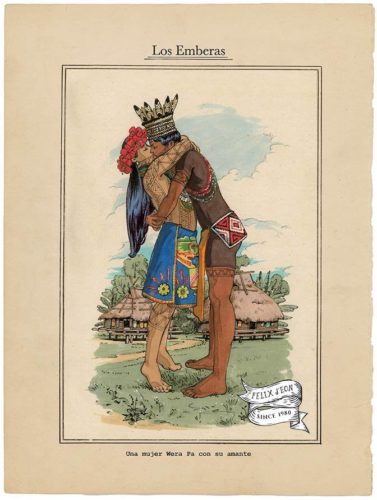
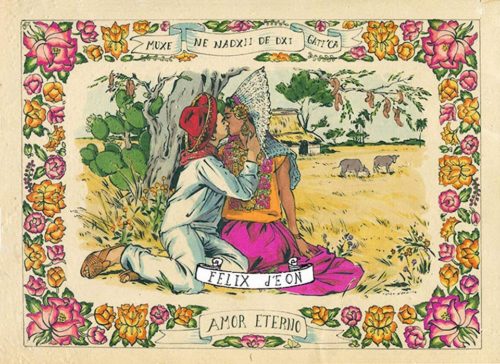
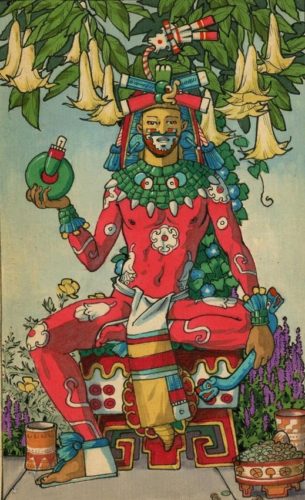
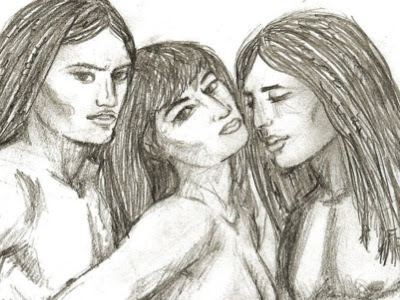





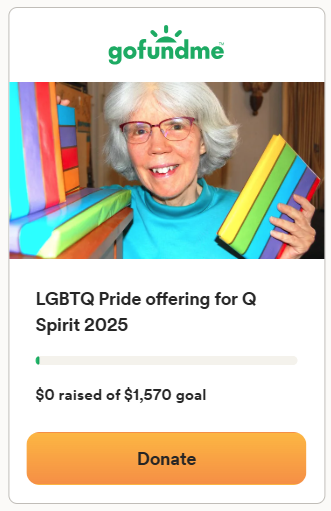
















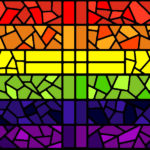

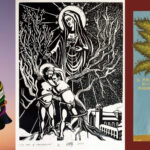
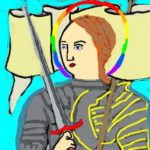
This is so intense and so enlightening!
Thank you very much for this article. It’s very interesting.
Actually, at the moment I’m writing a term paper at uni about indigenous contemporary art. Can you tell me where you found the picture of Brandon Buehring and the information about his biogrpahy? I tried to find his book “Legendary Love” but I was unable to find it. It would be great if you can help me out!
Maria, thanks for asking about Brandon Buehring. His “Legendary Love” website is gone now, but you can find his biography and contact info at these links:
https://www.linkedin.com/in/bbuehring/
https://sites.google.com/a/socialjusticeatwork.org/social-justice-at-work/about-us/about-brandon-buehring
Best wishes for your term paper on indigenous contemporary art!
The quote was from the book, Talking Back, Voices of Color published by Red Letter Press. We used the quote in an essay LGBTQ Ourstory Month: We are for liberation not reform published at http://www.furbirdsqueerly.wordpress.com. We have been using the word ourstory for years I think ever since herstory. We think it fits us more and includes all of us. Again thank you. I always am alerted through Tony Nada about your work.
Kittredge Thank you so much for this article and for bringing to my attention so many more of our 2 spirit ancestors to be added to our wonderful stories. It is amazing to see during the past 50+ years how much has been removed from the straight jackets and from between the lines by scholars, artists, historians and others. This was from an essay we published about LGBTQ Ourstory month: “That place of not knowing was just another form of oppression keeping us all in down. As Socialist Feminist Nelly Wong said, “Exploring ideas and finding long hidden history (ourstories) is a form of finding voice.” If we ever wish to be truly liberated we must come from a place of a deep understanding of our people’s stories.” I thank you again for these ourstories.
Thank you for a powerful comment that encourages me to keep on researching, writing and posting our history. I have heard the term “herstory” for women’s history, but this is the first time I encountered “ourstory” — cool new term! Where can I read the whole essay that you quoted?